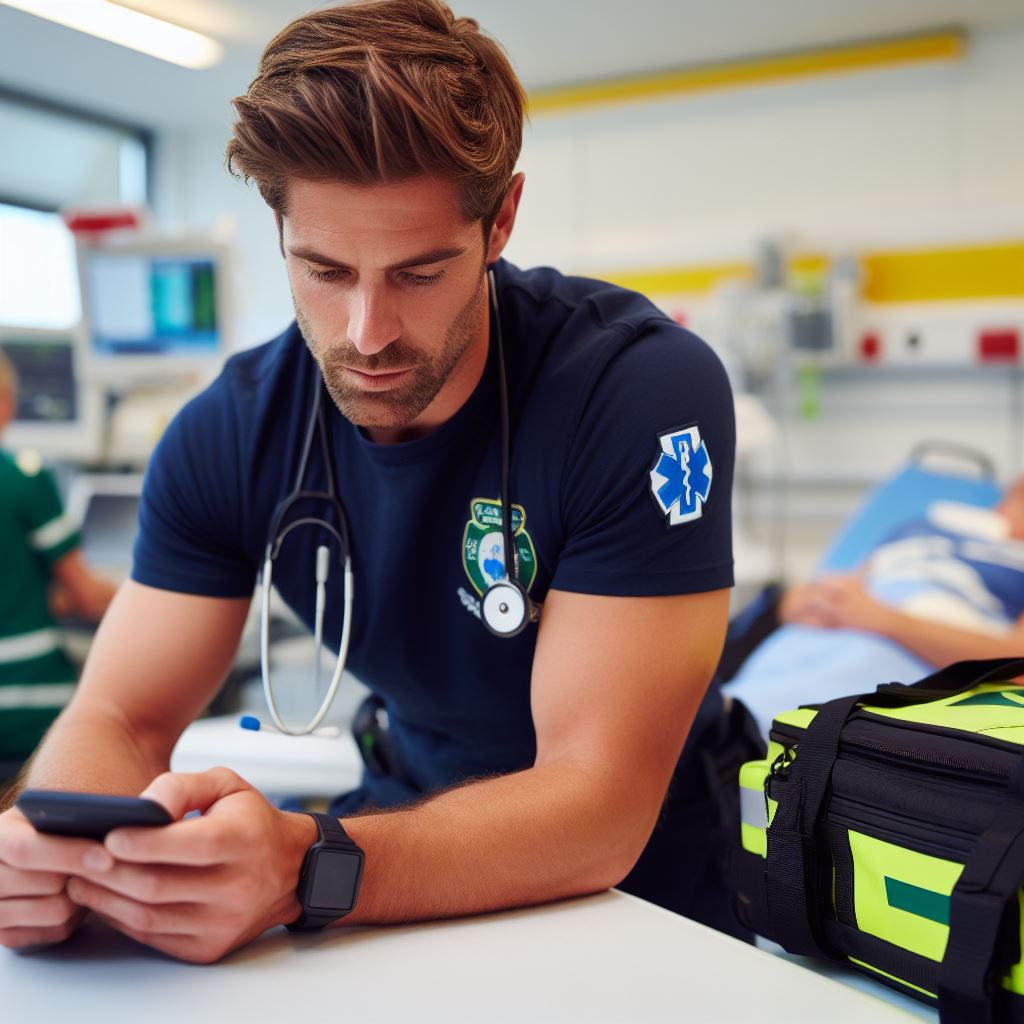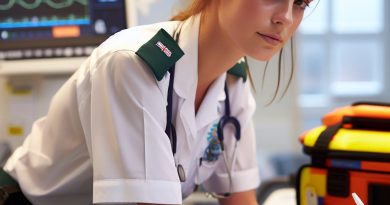Technology in UK Paramedic Services Today
Last Updated on January 27, 2024
Introduction
Technology has become an integral part of paramedic services in the UK, revolutionizing the way emergency medical care is provided. It plays a vital role in enhancing patient outcomes and improving overall efficiency.
Importance of technology in paramedic services
The use of advanced technology in paramedic services is crucial as it helps in accurately assessing and managing patients’ conditions.
It enables paramedics to make more informed decisions and provide timely and appropriate treatment.
Technology advancements in the UK
The UK has witnessed significant technological advancements in paramedic services.
Mobile data terminals enable paramedics to access patients’ medical histories and transmit vital information to hospitals in real-time. This ensures that patients receive the required care promptly.
Telemedicine has also gained prominence, allowing paramedics to receive guidance from specialized doctors remotely.
This not only enhances treatment options but also reduces the need for hospital transfers.
In addition, wearable technology and remote monitoring devices have greatly aided paramedics in monitoring patients’ vital signs and collecting data.
This enables early detection of potential complications and improves the efficiency of pre-hospital care.
Furthermore, the introduction of automated external defibrillators (AED) in ambulances and public spaces has increased the chances of survival for patients experiencing cardiac arrests.
Technology continues to shape the future of paramedic services in the UK, providing paramedics with invaluable tools to deliver prompt and effective care.
As technology continues to advance, the possibilities for improving emergency medical services are endless.
Role of Technology in Emergency Response
In today’s UK Paramedic Services, technology plays a vital role in improving emergency response and patient care.
From GPS and navigation systems to mobile data terminals and electronic patient care records, technology has revolutionized paramedic services.
Use of GPS and Navigation Systems
The use of GPS and navigation systems has significantly enhanced emergency response times.
Paramedics can now quickly and accurately locate the scene of an incident, reducing delays and ensuring prompt medical attention.
These systems also enable paramedics to identify the most efficient routes, avoiding traffic congestion and saving crucial minutes.
Mobile Data Terminals for Communication
Mobile Data Terminals (MDTs) have become invaluable tools for communication in paramedic services. These devices enable real-time communication between dispatchers and paramedics on the field.
Paramedics can receive vital information about patients and incidents, allowing them to prepare adequately before arrival.
MDTs also facilitate instant updates to the patient’s condition and relay essential details to hospital staff, ensuring seamless care transition.
Another significant technological advancement is the adoption of electronic patient care records.
Traditionally, paramedics relied on handwritten notes, which were prone to errors and difficult to share with other healthcare professionals.
However, electronic patient care records now allow paramedics to create digital records that contain vital information regarding a patient’s condition, medications, and previous medical history.
These records can be easily accessed and shared with hospitals, enabling healthcare providers to make informed decisions and deliver precise care.
Electronic Patient Care Records
Moreover, electronic patient care records improve continuity of care in cases where patients require ongoing treatment or follow-ups.
With digital records, paramedics can easily update and share patient information with General Practitioners or specialists, ensuring a seamless transition of care between different healthcare settings.
Additionally, technology has facilitated the implementation of telemedicine in paramedic services.
Paramedics can now connect with specialists remotely, enabling instant consultations and guidance in critical situations.
This capability enhances the quality of care provided on-site and allows paramedics to receive immediate support and advice from specialists, ultimately leading to better patient outcomes.
The advancements in technology, however, require paramedics to maintain a strong understanding of the equipment and systems they use.
Specialized training programs are essential to ensure paramedics can operate and troubleshoot these technologies effectively.
Continuous education and updates are crucial to keep up with the ever-evolving landscape of technology in paramedic services.
In essence, technology has transformed UK Paramedic Services, revolutionizing emergency response and improving patient care.
The utilization of GPS and navigation systems, mobile data terminals, and electronic patient care records has led to faster response times, enhanced communication, and more accurate documentation.
These technological advancements will continue to shape the future of paramedic services, ensuring better outcomes for patients in times of crisis.
Technology in UK Paramedic Services Today
Telemedicine in Paramedic Services
In today’s rapidly changing world, technology has increasingly become an integral part of paramedic services in the UK.
One significant advancement in this field is the use of telemedicine, which allows remote consultation with physicians.
Remote Consultation with Physicians
Paramedics can now connect with doctors remotely, enabling them to receive real-time guidance and support during emergencies. This not only enhances the quality of care but also improves patient outcomes.
Use of Video Conferencing for Medical Advice
Video conferencing technology allows paramedics to consult with physicians visually and audibly, providing a more comprehensive assessment of the patient’s condition.
This facilitates accurate diagnosis and appropriate treatment decisions.
Enhanced Care for Patients in Remote Areas
Telemedicine has revolutionized paramedic services by extending quality healthcare to patients in remote areas.
With teleconsultation, these patients now have access to specialized medical advice without having to travel long distances.
Immediate Access to Medical Expertise
Through telemedicine, paramedics have immediate access to medical expertise, even in challenging situations.
By collaborating with physicians, they can receive valuable guidance, leading to improved decision-making and better patient care.
Reduced Response Time
Technology has made it possible for paramedics to communicate with doctors and receive instructions promptly.
This reduces response time significantly, especially during critical emergencies, where every second counts.
Specialized Treatment for Specific Cases
Telemedicine allows paramedics to seek specialized treatment guidelines for specific cases, ensuring the best possible care for patients with unique medical conditions or complex symptoms.
Continuous Training and Education
Paramedics can take advantage of telemedicine to access continuous training and education programs.
By attending virtual workshops and conferences, they can stay updated with the latest medical advancements and improve their skills.
Efficient Resource Allocation
By utilizing telemedicine, paramedic services can efficiently allocate resources.
This technology enables paramedics to consult with physicians, ensuring that patients are directed to the most appropriate level of care.
Improved Documentation and Record-Keeping
Telemedicine technology provides an efficient platform for documenting patient encounters.
Accurate and comprehensive records contribute to better information sharing among healthcare professionals, leading to enhanced patient safety.
Cost-Effective Solution
The use of telemedicine in paramedic services offers a cost-effective solution. It reduces unnecessary hospital admissions and transfers while still providing patients with necessary medical advice and care.
Challenges and Future Prospects
Although telemedicine has proven to be a valuable tool in the UK paramedic services, there are challenges that need to be addressed.
Ensuring secure and reliable internet connectivity is crucial for seamless telecommunication.
Additionally, proper training and education for paramedics on using telemedicine technology effectively are essential. Familiarity with the equipment and protocols is critical for optimizing the benefits of telemedicine.
In the future, advancements in telemedicine technology may enable paramedics to perform remote diagnostic tests, such as ECGs and ultrasounds, under the guidance of physicians.
This would further expand the scope of paramedic services and improve patient care.
Telemedicine has transformed UK paramedic services by bridging the gap between paramedics and physicians.
This technology has revolutionized the way paramedics deliver care, ensuring enhanced outcomes for patients, particularly those in remote areas.
As telemedicine continues to evolve, it holds the potential to further optimize paramedic services and ultimately improve the overall healthcare system.
Read: UK Nurse Salaries: What You Can Expect in 2024
Advancements in Medical Equipment
In today’s UK paramedic services, there have been remarkable advancements in medical equipment.
These innovations have revolutionized the way paramedics deliver care and improved patient outcomes. Let’s explore some of these groundbreaking developments.
Portable diagnostic devices
The introduction of portable diagnostic devices has revolutionized the initial assessment of patients.
Paramedics can now conduct on-site tests, such as blood glucose level monitoring or cardiac enzyme measurements, without having to wait for lab results.
This enables them to deliver targeted interventions or determine whether the patient requires urgent hospitalization.
Paramedics now have access to handheld devices that can quickly diagnose various medical conditions.
These portable devices are equipped with advanced sensors and software algorithms to accurately identify illnesses or injuries.
They enable paramedics to make critical decisions on-site, saving valuable time and improving patient care.
Automated CPR devices
Moreover, automated CPR devices have improved the quality of chest compressions during resuscitation efforts.
These devices maintain a consistent compression depth and rate, reducing the risk of human error and increasing the chances of successful revival.
Paramedics can focus on other essential tasks while the automated CPR device ensures uninterrupted circulatory support to the patient.
Cardiopulmonary Resuscitation (CPR) is a crucial lifesaving procedure performed in emergency situations such as cardiac arrest. Traditionally, CPR required manual chest compressions by paramedics.
However, with the introduction of automated CPR devices, the process has become more efficient and effective.
These devices deliver consistent and standardized compressions, ensuring optimal blood flow to the heart and brain.
Portable ultrasound machines
Portable ultrasound machines have become invaluable tools in the hands of paramedics.
They help identify internal bleeding, visualize trauma, or assess vital organ function.
In critical situations, these machines can provide immediate information to guide treatment decisions, enabling paramedics to act swiftly and effectively.
Ultrasound technology has made its way into paramedic services with the development of portable ultrasound machines.
These handheld devices offer real-time imaging capabilities, allowing paramedics to assess internal injuries, detect fractures, and identify potential medical emergencies.
Portable ultrasound machines have proven to be invaluable in remote areas where immediate access to a hospital is limited.
These advancements in medical equipment have had a significant impact on the efficiency and effectiveness of UK paramedic services.
They have empowered paramedics to provide accurate and timely care to patients in critical situations.
By leveraging these modern tools, paramedics can initiate appropriate treatments promptly, potentially saving lives and reducing complications.
In essence, the advancements in medical equipment in UK paramedic services have drastically transformed the way patient care is delivered.
Portable diagnostic devices, automated CPR devices, and portable ultrasound machines have played pivotal roles in improving outcomes for patients in emergency situations.
As technology continues to evolve, we can expect even more innovative tools to enhance the capabilities of paramedics and further save lives.
Read: Nurse Education: Degrees and Courses in the UK

Use of Drones in Paramedic Services
Fast delivery of medical supplies
In the ever-evolving world of technology, paramedic services in the UK are also embracing innovative solutions to enhance their operations.
One such development is the use of drones, which are proving to be a game-changer in the field.
Let’s explore how these unmanned aerial vehicles are transforming the way medical supplies are delivered.
They provide a valuable tool for aerial surveillance, along with the challenges and future possibilities they present.
Aerial surveillance for situational awareness
Drones in paramedic services enable fast delivery of medical supplies, ensuring timely and efficient assistance to those in need.
With their ability to navigate through traffic and rough terrains, drones can reach the desired location quickly, saving critical time in emergency situations.
These aerial vehicles can transport essential medical equipment such as defibrillators, medications, and even blood samples to hospitals or accident sites.
Aerial surveillance for situational awareness
Aerial surveillance is another significant application of drones in paramedic services.
By deploying drones equipped with high-resolution cameras, paramedics can gain a bird’s eye view of an incident or accident scene, providing crucial situational awareness.
This aerial footage helps them assess the scale of the situation, identify potential hazards, and formulate the most effective action plan.
It also assists in monitoring crowd control during large-scale events or assessing the damages and accessibility in disaster-stricken areas.
The use of drones in paramedic services is not without challenges. One of the major concerns is the need to comply with the strict regulations surrounding their usage.
Civil aviation authorities have established rules and guidelines to ensure the safe and responsible operation of drones.
These regulations include restrictions on flying near airports, limitations on the altitude and distance drones can cover, and the requirement of proper training and licensing for operators.
Adherence to these regulations is essential to avoid any potential accidents or disruptions.
Challenges and future possibilities
Another challenge is the limited payload capacity of drones.
While they can transport small medical supplies, the delivery of larger items such as bulky equipment or multiple blood units becomes problematic.
Innovations are being explored to overcome this limitation, including the development of specialized drones with increased carrying capacity.
The use of drones in conjunction with other modes of transportation to complete the delivery chain.
Despite the challenges, the future possibilities of drones in paramedic services are exciting.
Advancements in drone technology, such as the development of autonomous flight and artificial intelligence, hold great potential for enhancing their capabilities.
For example, drones equipped with advanced sensors and AI algorithms can help identify medical emergencies from indicators like heart rate or abnormal movements, allowing for proactive assistance even before a distress call is made.
Moreover, the integration of drones with telemedicine systems could revolutionize remote healthcare.
In scenarios where immediate physical intervention is not possible, paramedics can utilize drones to establish live video communication with medical professionals, enabling remote diagnosis and guidance for patients in critical conditions.
This integration would bridge the gap between on-site assistance and expert medical advice, significantly improving patient outcomes in remote or inaccessible areas.
In review, the use of drones in UK paramedic services is a significant technological advancement. They provide fast delivery of medical supplies and valuable aerial surveillance capabilities.
Despite challenges related to regulations and payload capacity, the future possibilities are vast, with the potential to enhance drones’ capabilities through advancements in technology.
The integration of drones with telemedicine systems holds promise for remote healthcare, ultimately benefiting patients and improving emergency response in the UK.
Read: Understanding UK Nursing Laws and Regulations
Data Analytics and Management
Utilization of big data in emergency response
Data analytics plays a crucial role in the UK paramedic services today. Paramedic teams are utilizing big data to improve emergency response.
By analyzing large sets of data collected from various sources, paramedics can gain valuable insights.
The utilization of big data in emergency response has revolutionized the way paramedics operate. With the help of advanced technology and data analytics, paramedics now have access to real-time information.
This allows them to make better-informed decisions and provide more effective treatment.
Predictive analytics for resource allocation
Predictive analytics is another area where data analytics is making a significant impact in the paramedic services.
By analyzing historical data, paramedics can predict potential emergencies and allocate resources accordingly. This proactive approach enables them to be better prepared and respond more efficiently.
The improvement of decision-making processes is an essential aspect of data analytics in paramedic services. Paramedics can now rely on data-driven insights to make critical decisions quickly and accurately.
This not only saves valuable time but also improves patient outcomes.
Data analytics and management also contribute to the overall improvement of paramedic services.
By analyzing trends and patterns in data, paramedics can identify areas for improvement and implement necessary changes.
This continuous feedback loop ensures the constant evolution and enhancement of the services.
In addition to data analytics, technology plays a crucial role in the management of data in paramedic services.
Digital systems and software are used to collect, store, and analyze data. This streamlines the processes and allows paramedics to access information quickly and efficiently.
Improvement of decision-making processes
The utilization of big data and data analytics in paramedic services has numerous benefits. It allows for improved resource allocation, better decision-making, and enhanced overall service quality.
By harnessing the power of data, paramedics can provide faster and more effective emergency response.
Paramedics can also leverage data analytics to identify areas with high demand and allocate resources accordingly.
This helps in optimizing resource utilization and ensuring that emergency situations are dealt with promptly and efficiently.
Furthermore, data analytics can help in identifying trends and patterns in patient conditions, enabling paramedics to detect potential outbreaks or public health emergencies.
This early detection can lead to timely intervention and prevent widespread damage.
In general, data analytics and management have transformed the landscape of UK paramedic services.
The utilization of big data and predictive analytics has greatly improved emergency response and resource allocation.
By embracing technology and data-driven decision-making processes, paramedics can provide better care and save more lives.
Read: The Path to Becoming a Nurse in the UK Explained
Discover More: Medical Ethics: A UK Surgeon’s Perspective
Ethical Considerations and Challenges
Paramedic services in the UK are facing ethical considerations and challenges when it comes to the use of technology.
These challenges include privacy concerns related to patient data, training and ensuring competency in technology use, and balancing technology reliance with human judgment and compassion.
Privacy Concerns Related to Patient Data
- Paramedics now have access to electronic health records, raising concerns over the privacy and security of patient data.
- There is a need for stringent measures to be in place to protect sensitive patient information from unauthorized access.
- Maintaining patient confidentiality is of utmost importance, and paramedics must handle patient data ethically and responsibly.
Training and Ensuring Competency in Technology Use
- Paramedics must undergo extensive training to effectively use technology-based tools and equipment in their practice.
- Continuous education and competency assessments are necessary to keep up with the rapidly evolving technological advancements.
- Ensuring paramedics have the necessary skills and knowledge is crucial to provide quality care using technology.
Balancing Technology Reliance with Human Judgment and Compassion
- While technology has its benefits, it is important to remember that it should never replace human judgment and compassion in healthcare.
- Paramedics need to strike a balance between relying on technology for accurate assessments and using their clinical expertise and empathy when interacting with patients.
- Personal interactions and emotional support are essential, and technology should enhance, not replace, these aspects.
Essentially, as technology becomes more prevalent in UK paramedic services, ethical considerations and challenges arise.
Privacy concerns related to patient data, the need for training and competency in technology use, and balancing technology reliance with human judgment.
Compassion all play crucial roles in providing safe and effective care.
It is essential to address these challenges and ensure that the use of technology aligns with ethical standards and enhances patient care.
Conclusion
Technology plays a crucial role in UK paramedic services today. It has improved response times and communication between paramedics and hospitals.
Additionally, advancements in technology have allowed for more accurate diagnosis and treatment options.
Importance of technology in UK paramedic services
Technology has enhanced emergency response in the UK by enabling real-time communication and efficient coordination among paramedics.
The use of electronic patient care records has improved patient care and reduced errors in medical documentation.
Moreover, wearable devices and telemedicine have improved pre-hospital care and expanded access to medical expertise.
Future prospects and potential advancements in the field
Looking ahead, there are promising advancements on the horizon for technology in UK paramedic services.
Artificial intelligence and machine learning can aid in diagnosing conditions and predicting patient outcomes.
Drones equipped with medical supplies can provide rapid assistance in remote areas. Virtual reality training programs can improve paramedic education and skills.
Finally, the integration of technology with emergency medical services will continue to enhance efficiency and patient care.
With technological advancements, UK paramedic services are better equipped to handle emergencies and provide timely and effective care to patients.
As technology continues to evolve, the future of paramedic services looks even brighter, with potential advancements that can further improve emergency response and patient outcomes.


